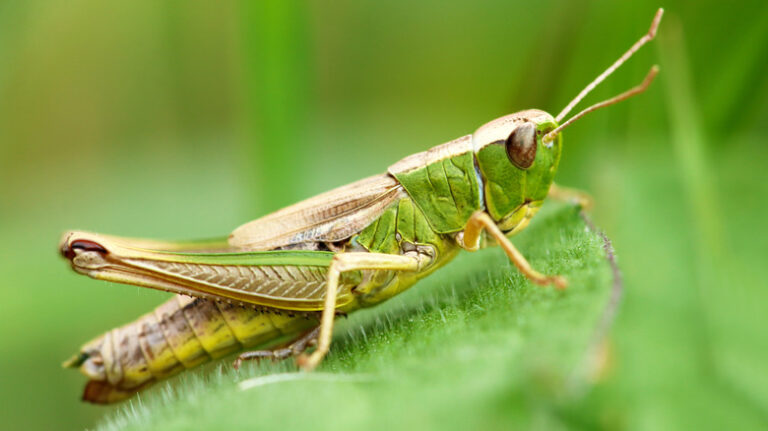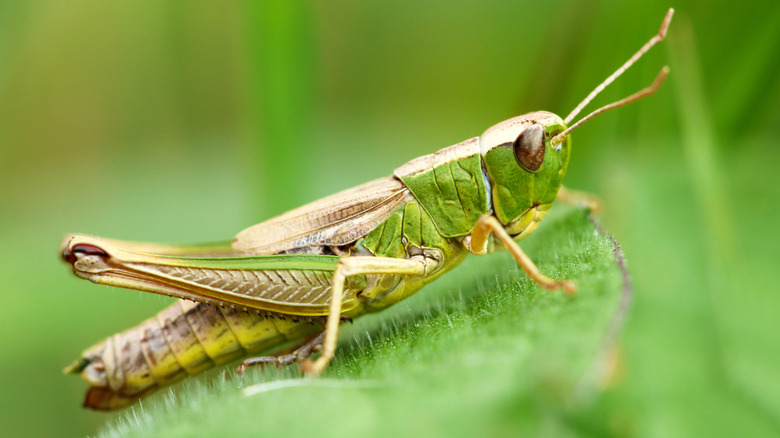Table of Contents
What Are Grasshoppers?
Grasshoppers are insects belonging to the order Orthoptera, which also includes crickets and locusts. They are typically characterized by their long hind legs, which are adapted for jumping, and their ability to produce a chirping sound by rubbing their hind legs or wings together. Grasshoppers have chewing mouthparts and feed primarily on plant matter, including grasses, leaves, and other vegetation. They play important roles in ecosystems as both prey for various animals and as plant eaters that can affect vegetation growth.
6 Types of Grasshoppers
Grasshoppers are a diverse group of insects, with thousands of species found worldwide. Here are a few notable types of grasshoppers:
Green Grasshoppers: These are among the most common types of grasshoppers, often found in fields and grassy areas. They are typically green or brown in color, blending well with their surroundings.
Red-winged Grasshoppers: These grasshoppers have distinct red or orange markings on their wings, which they may display when startled or in flight. They are often found in open habitats such as meadows and prairies.
Differential Grasshoppers: These large grasshoppers are known for their variable coloration, ranging from green to brown. They are agricultural pests in many areas, feeding on crops such as corn, soybeans, and alfalfa.
Migratory Locusts: While technically a type of grasshopper, locusts are known for their ability to swarm and migrate over long distances in search of food. When conditions are right, solitary grasshoppers can form swarms of millions, causing significant damage to crops.
Katydids: Although not true grasshoppers, katydids are closely related and share similar habitats and behaviors. They are often green and leaf-shaped, blending in with foliage, and are known for their loud, continuous chirping at night.
Short-horned Grasshoppers: This is a diverse group of grasshoppers characterized by their relatively short antennae compared to their body length. They can vary greatly in size, color, and habitat preferences.
These are just a few examples, and there are many more species of grasshoppers, each with its own unique characteristics and adaptations.
How to Get Rid of Grasshoppers
Controlling grasshoppers can be challenging, especially in large numbers, but here are several methods you can try to reduce their population:
Physical Barriers: Install physical barriers such as fine mesh netting or row covers to protect vulnerable plants from grasshopper feeding. Make sure the barriers are securely in place and cover the plants completely.
Handpicking: In small gardens or localized infestations, you can manually remove grasshoppers by hand. Simply pick them off plants and drop them into a bucket of soapy water to kill them.
Natural Predators: Encourage natural predators of grasshoppers, such as birds (like chickens), toads, lizards, and predatory insects like spiders and praying mantises. Providing habitat for these predators can help keep grasshopper populations in check.
Biological Control: Consider introducing natural enemies of grasshoppers, such as certain species of parasitic wasps or pathogens like Nosema locustae, which specifically target grasshoppers. These biological control agents can help reduce grasshopper populations without harming other beneficial insects.
Botanical Repellents: Some plants, such as tansy, cilantro, and calendula, are known to repel grasshoppers. Planting these around susceptible crops or as a border in your garden may help deter grasshoppers.
Chemical Control: If grasshopper populations are severe and other methods have failed, chemical insecticides can be used as a last resort. However, be cautious with chemical pesticides, as they can harm beneficial insects and other wildlife. Always follow label instructions carefully and consider using less harmful, targeted products.
Cultural Practices: Implement cultural practices that can make your garden less attractive to grasshoppers. This may include removing weeds and plant debris where grasshoppers lay eggs, rotating crops to disrupt grasshopper breeding sites, and maintaining healthy soil to promote plant resistance.
Trap Crops: Plant trap crops such as sunflowers or mustard greens to attract grasshoppers away from valuable crops. Once grasshoppers congregate on the trap crops, you can then remove or treat them more easily.
By using a combination of these methods and monitoring your garden regularly, you can effectively manage grasshopper populations and protect your plants.

6 Harmful Effects of Grasshoppers on Plants
Grasshoppers can have several harmful effects on plants, particularly when they occur in large numbers or during periods of high activity. Some of the primary ways in which grasshoppers can damage plants include:
Feeding Damage: Grasshoppers are voracious feeders and can consume large quantities of plant material, including leaves, stems, flowers, and even fruits. Their chewing mouthparts can cause significant damage to crops and ornamental plants, leading to reduced yields, stunted growth, and sometimes even plant death.
Defoliation: Grasshoppers can strip plants of their foliage, leaving them bare and vulnerable. Severe defoliation can weaken plants, reduce their ability to photosynthesize and produce energy, and make them more susceptible to diseases and other stresses.
Crop Losses: Grasshoppers are known to feed on a wide range of crops, including grains, vegetables, fruits, and ornamentals. When populations are high, they can cause substantial economic losses for farmers and gardeners by damaging valuable crops and reducing yields.
Stress and Stunting: Even if plants are not completely defoliated, constant feeding by grasshoppers can stress them and inhibit their growth and development. This can result in stunted or malformed plants that produce lower-quality fruits or flowers.
Transmission of Diseases: In addition to directly feeding on plants, grasshoppers can also serve as vectors for plant diseases. They may pick up pathogens from infected plants and transmit them to healthy plants as they feed, further compromising plant health and productivity.
Secondary Damage: Grasshopper feeding can attract other pests, such as rodents and insects, that are attracted to damaged or weakened plants. This can lead to additional problems and complicate pest management efforts.
Overall, the harmful effects of grasshoppers on plants can be significant, particularly in agricultural settings where crops are the primary source of income or food. Effective management strategies are important to minimize damage and protect plant health and productivity.
FAQs
What do grasshoppers eat? Grasshoppers are herbivorous insects that primarily feed on plant material such as leaves, grasses, stems, flowers, and crops like grains and vegetables.
Do grasshoppers bite humans? Grasshoppers do not typically bite humans. They are not aggressive towards people and usually only use their mouthparts for feeding on plants.
How long do grasshoppers live? The lifespan of a grasshopper varies depending on species and environmental factors. Generally, adult grasshoppers can live for several weeks to several months.
Do grasshoppers fly? Yes, grasshoppers are capable of flight. They have wings that allow them to fly short distances to escape predators or search for food and mates.
What is the difference between grasshoppers and locusts? Grasshoppers and locusts are closely related insects belonging to the same order (Orthoptera). The main difference lies in their behavior: grasshoppers typically live solitarily and do not form swarms, while locusts have the ability to undergo a physiological and behavioral transformation, forming swarms of individuals that can cause significant agricultural damage.
How do grasshoppers produce sound? Grasshoppers produce sound by rubbing their hind legs or wings together in a process called stridulation. This sound is often used for communication, such as attracting mates or establishing territory.
Are grasshoppers harmful to plants? Yes, grasshoppers can be harmful to plants, especially in large numbers. They feed on plant material, which can lead to defoliation, stunted growth, reduced yields, and sometimes plant death.
What are natural predators of grasshoppers? Natural predators of grasshoppers include birds, toads, lizards, spiders, predatory insects (such as praying mantises and predatory wasps), and certain pathogens.
How can I control grasshopper populations in my garden? There are several methods to control grasshoppers, including physical barriers, handpicking, encouraging natural predators, using biological control agents, planting repellent plants, and implementing cultural practices to make your garden less attractive to grasshoppers.
Are grasshoppers beneficial for anything? While grasshoppers can be pests in agricultural settings, they also play important roles in ecosystems as prey for various animals and as plant eaters that can influence vegetation growth and diversity.
Share this post:




